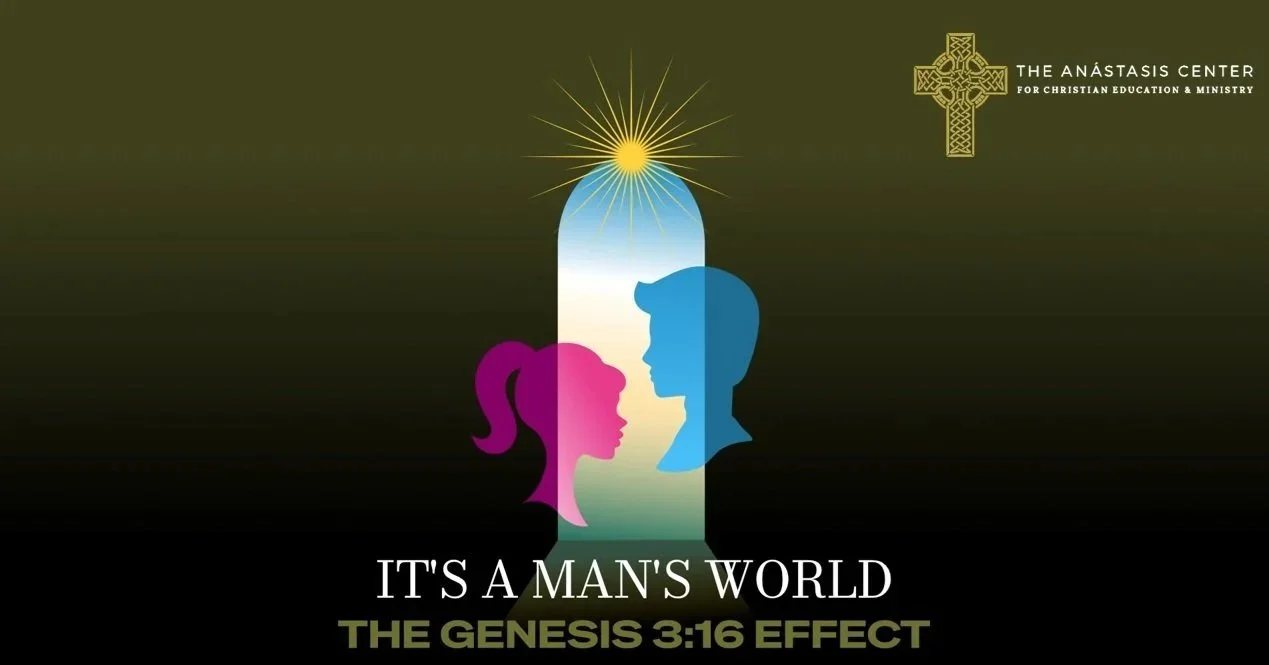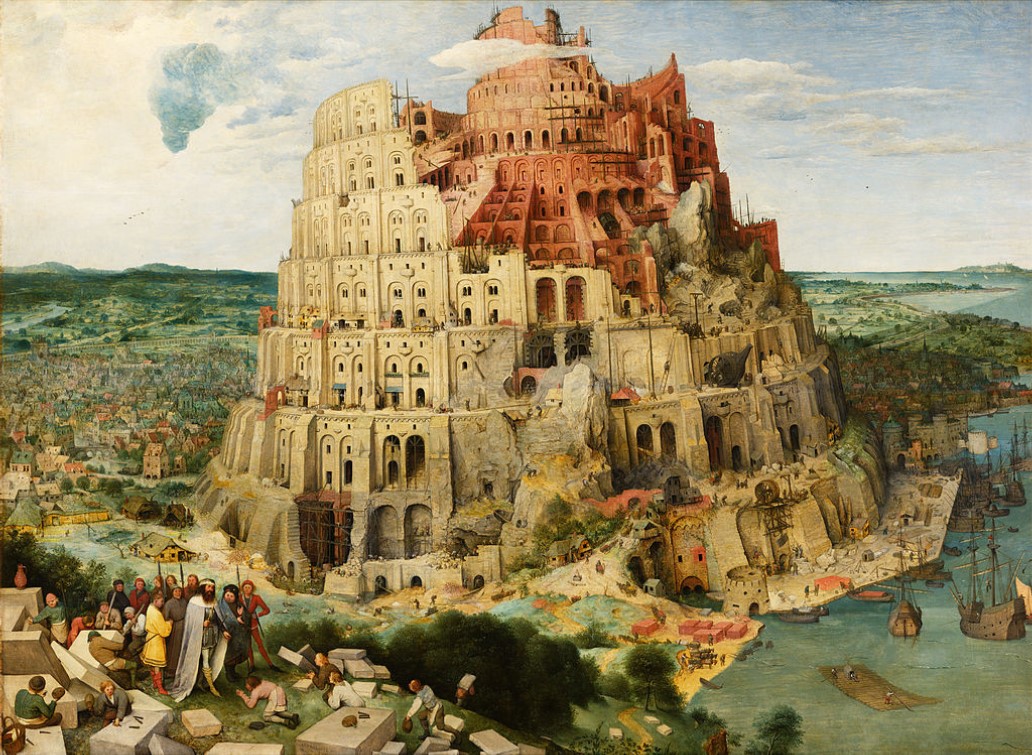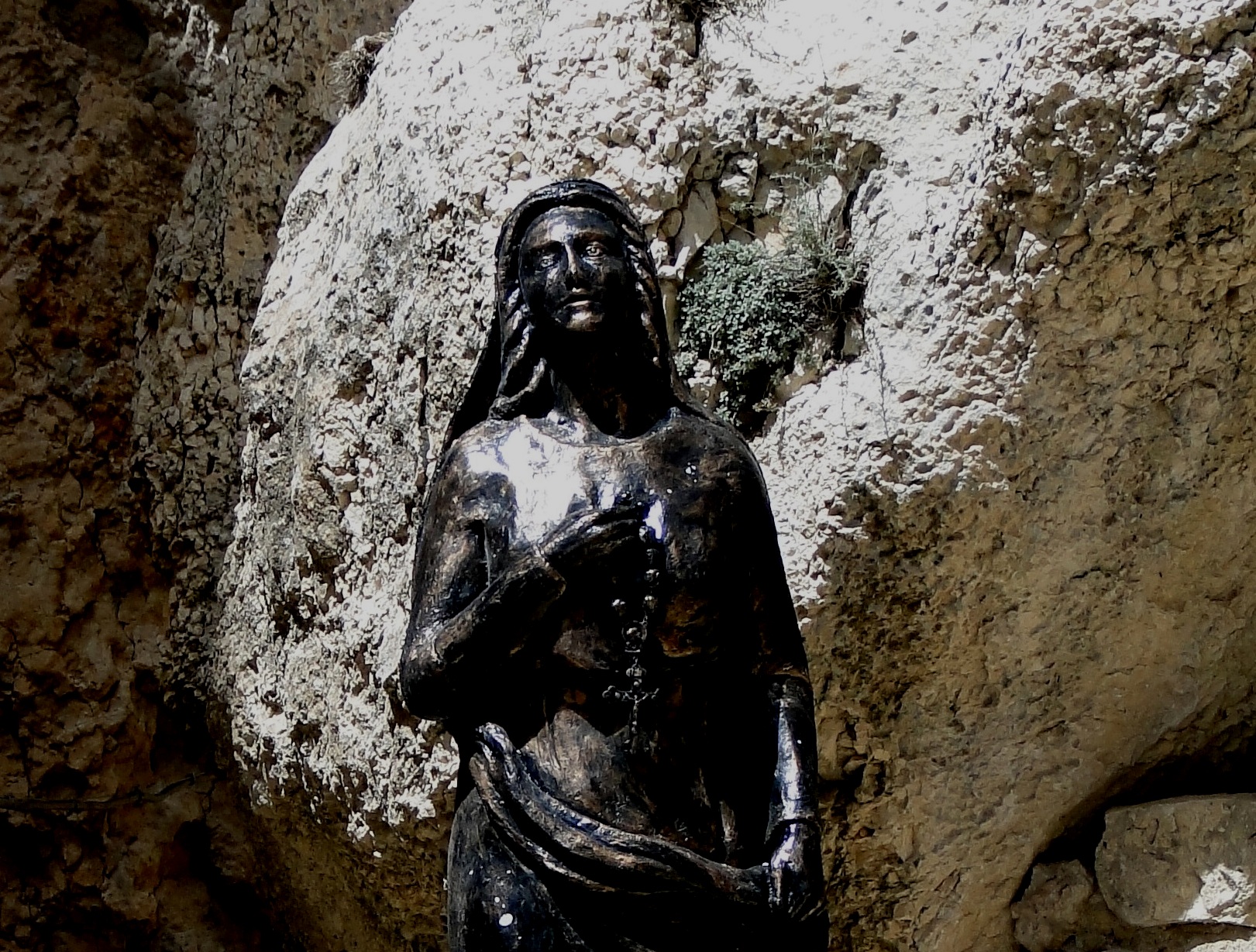The Church and Women’s Leadership
Photograph: A statue of Saint Thecla in the gorge of Saint Thecla, Ma'loula, Syria. Photo credit: Bernard Gagnon | CC3.0, Wikimedia Commons.
Introduction
Starting in the mid to late second century, a Christian work called The Acts of Paul and Thecla circulated very broadly and enthusiastically in the Mediterranean region. It is probably a mix of fact and pious fiction. In it, Thecla, a disciple of Paul who was blessed by him, preached and ministered to both men and women in the region of Asia Minor. Tertullian of Carthage complained that some Christians were using the story of Thecla to advocate for women baptizing and preaching. This is one data point suggesting that women had considerable authority in ministry and in the church in the earlier period of the church; see Stephen J. Davis, The Cult of Saint Thecla: A Tradition of Women’s Piety in Late Antiquity, published by Oxford University Press (2008). In the Eastern Orthodox Church, Thecla is honored as a saint, protomartyr, and equal to the apostles.
The Anástasis Center takes the egalitarian position on women in both marriage and church leadership. We do this because of our conviction that God’s justice is restorative: Jesus restores and resumes in his new creation what God started in His original garden creation. In the original creation, God made Eve equal to Adam, and even greater in her life-bearing capacity. So, in Jesus’ new creation, we are to honor men and woman as equals.
The resources below interpret both Scripture and church history as an argument for women at all levels of church leadership. First come materials on Scripture. Second come materials on church history. Third come materials addressing the mistaken claim that the Trinity is a hierarchy of power, which is what some Protestant evangelicals argue in favor of patriarchy. Fourth come examples of the status of women in Christian-influenced cultures, both positive and negative.
Messages and Resources on the Church and Women’s Leadership in Scripture
Join Hayley Rose (M.A. NCC LPC) and Rachel Darnall (M.A. Theological Studies) as we explore the causes, effects and cure for gender hierarchy in eight video episodes covering areas including: Moral responsibility; work and compensation; reproduction and parenthood; civic life; education; marriage; sexual agency.
Participants will learn the surprising truth about why patriarchy happens, how it’s developed and mutated throughout history, and how Christians can honor God’s original plan for gender equality and co-rule while living in “a man’s world.”
The Theme of Women in Judges, and the Portrayal of Deborah as Leader
Notes on how Deborah is portrayed as a prophet like Moses, and the significance of her portrayal for the entire Book of Judges and the rest of the biblical canon.
Women Speaking Authoritatively in the Worship Service in 1 Corinthians 11
This passage indicates that women and men preaching and praying was a standard practice in the earliest congregations. It was established before Paul. This means that the embodied practice of headship including women preaching authoritatively. I argue that this unique Christian worship context controlled the meaning of the word head (Greek kephale). It is therefore a mistake for Protestants to claim 'sola Scriptura' in such a way that scholars look for the meaning of kephale from the Septuagint Old Testament of the Greek usage outside the New Testament. That method does not account for the hermeneutical priority of 1 Corinthians 11.
Women and Speech in 1 Corinthians 11 and 14
This is a comparison of all the possible combinations of how two major passages about women speaking can and must be interpreted together.
This argument for the entirety of 1 Timothy being a chiasm means that the "widows" of ch.5 correspond to the "elders" of ch.3. The paper also discusses the meaning of the Greek word authentein in 2:12 versus the standard Greek word for legitimate and proper authority, exousia. The entirety of 1 Timothy is shown to support women in church leadership and preaching-teaching authority.
Paul's View of Headship in Marriage: How 1 Corinthians Interprets Ephesians and Colossians
The word "head" (Greek kephale) was normatively defined by 1 Corinthians 11, where women preached, representing the head to the body. Therefore, people who have not had the experience of sitting under the authority of a female preacher-teacher have an incomplete understanding of headship, and probably an exclusively male understanding, which is defective. Also, the ethics of marriage taught in 1 Corinthians can be shown to take logical priority (not hermeneutical priority, except in a simplistic sense) over the ethics of marriage taught in Ephesians and Colossians.
Women Restored, Women Restoring
A thematic study of Luke - Acts, which uses a literary methodology to argue that women had authority in creation, because they have authority in Jesus' new creation.
A presentation given May 7, 2022 to the 2022 Reconstruction class, accompanying the video. Greek and Roman views of the inferiority of women began with Plato and Aristotle (4th century BC). But Pulcheria was a Christian woman who became Roman augusta in 414 AD and presided over the Third and Fourth Ecumenical Councils. Empress Theodora was very influential in the 500s. And Irene became Emperor of the Romans by 800 AD. How did this happen? This presentation explores vocation as the main category by which Christians empowered women in roles distinct from family, examining the Catacombs of Priscilla, Irenaeus of Lyons, The Acts of Paul and Thecla, the Martyrdom of Perpetua and Felicitas, Montanism and the orthodox reaction to it, Melania the Elder, Paula of Rome, Nino of Georgia, Brigit of Ireland. The presentation also discusses the disagreements between Irenaeus, Tertullian, and Origen about how to interpret women in 1 Corinthians 11. This presentation and the video are the second of the 2022 Reconstruction class topics on the early church. See also our YouTube channel Reconstruction playlist for all the videos.
Women in Church Leadership part 1 and part 2
Slides of a presentation examining the key biblical passages.
Women in Church Leadership and Biblical Translation
A short letter response to a friend who asked about issues present in Bible translation
The Rights of Women in the Bible
An exploration of women's rights — both protections and opportunities — in the various roles they found themselves in throughout the biblical narrative. Mako presented a shorter version of this to the International Christian Alliance on Prostitution Conference in 2019. This file is large, so it can also be found in two smaller parts: part 1 and part 2.
Christian Ethics of Organization: The Church, Organizations, and Organizational Authority
A long essay exploring authority in the church, and Christian ethics for any and all organizations
-
Wikipedia, Athaliah (Wikipedia article), daughter of King Ahab and Queen Jezebel, is significant because she was the first regnant queen to rule the people of Israel — in her case, the Northern Kingdom of Israel — from 842 - 837 BCE. She was villainous, as she tried to kill all the Davidic heirs, and seized the throne of Judah. Athaliah was thwarted by another woman, Jehosheba, who rescued the infant Jehoash. See also Tamar Kadari, Athaliah: Midrash and Aggadah. Jewish Women’s Archive.
Wikipedia, Salome Alexandra (Wikipedia article) is significant because she reigned in the intertestamental period, on the throne of Judah, from 76/75 BCE to 67 BCE. See also Henry Abramson, Women in Ancient Israel | Jewish History Lab Episode 36. Henry Abramson, Jan 10, 2021. Abramson gives fascinating insights into the biblical and talmudic tradition.
Marg Mowczko, Does Isaiah 3:12 Say Women Leaders Are a Bad Thing? Marg Mowczko, Feb 20, 2016.
“The Hebrew word for women in Isaiah 3:12 is nashim (נשים). With identical consonants, the word can also be read as noshim (נשים), which means “creditors.” The Aramaic Targum Jonathan of Isaiah 3:12 has nosim (“creditors”). Accordingly, the New English Translation (NET) translates the pertinent phrase as “creditors rule over them”. The Septuagint was translated from Hebrew to Greek centuries before the Masoretes added their system of vowel points to the Hebrew text. (It is these later vowel points that distinguish nashim from noshim.) The Septuagint’s version of Isaiah 3:12a (translated into English) reads: “O my people, your extractors strip you, and extortioners rule over you.”
Kathleen E. Corley, Maranatha: Women's Funerary Rituals and Christian Origins. Fortress Press | Amazon page, Apr 2010. Corley studies funeral rites and customs in the ancient Roman world; she compares them to the Gospels’ accounts of the women at Jesus’ empty tomb announcing his resurrection, finding a new role for women mourners at the heart of Christian faith
Gordon Hugenberger, Women in Church Office: Hermeneutics or Exegesis? A Survey of Approaches to 1 Tim 2:8 – 15. Journal of Evangelical Theology Society, Sep 1992.
Gregory of Nyssa, Epistle 19, ch.6, said
“We had a sister who was for us a teacher of how to live, a mother in place of our mother. Such was her freedom towards God that she was for us a strong tower. Psalm 60:4) and a shield of favor. Psalm 5:13) as the Scripture says, and a fortified city. Psalms 30:22; 59:11) and a name of utter assurance, through her freedom towards God that came of her way of life.”
Wijngaards Institute for Catholic Research, Jesus Empowered Women to Preside at Eucharist. Wijngaards Institute for Catholic Research.
Wijngaards Institute for Catholic Research, Women Deaconnesses in Historical Records. Wijngaards Institute for Catholic Research. See also John Wijngaards, Reconstruction of the Ordination Rite of Women Deacons. Wijngaards Institute for Catholic Research. This explores the ordination rite recovered in the Byzantine (Eastern Roman) realm.
Elizabeth A. Clark, Women in the Early Church. Liturgical Press | Amazon page, 1983.
Thomas F. Torrance, The Ministry of Women. Touchstone Magazine, Fall 1992.
Ute E. Eisen, Women Officeholders in Early Christianity: Epigraphical and Literary Studies. Liturgical Press | Amazon page, 2000.
N.T. Wright, Gender and the Biblical Basis for Women's Service in the Church. Christians for Biblical Equality International, Mar 29, 2017.
Dennis J. Preato, Empirical Data in Support of Egalitarian Marriages and A Fresh Perspective on Submission and Authority. God's Word to Women, Apr 23, 2004. Note the comments on Cyril, Theodore, and John Chrysostom and their engagement with 1 Corinthians and Ephesians based on an Athanasian view of the Trinity, where the Son is the power of the Father, in 1 Corinthians 1:24, rather than an Augustinian view of the Trinity, where the Son has power, but the Father has more.
Kevin Madigan, editor, Ordained Women in the Early Church: A Documentary History. Amazon page, 2005.
Gordon Hugenberger, Women in Leadership. Original paper given at Park Street Church, Apr 14, 2008. Read by Jonathan and Monica Romig, Jan 23, 2023.
Scot McKnight, Women Preachers - A Story Often Neglected. BeliefNet, Aug 2010.
Jimmy Carter, Losing My Religion for Equality. Women's Press, Jan 25, 2013.
Rachel Pietka, Hey John Piper, Is My Femininity Showing? The Implications of Allowing Women to Teach "Indirectly". Christianity Today, Apr 2013.
Sarah Bessey, Jesus Feminist: An Invitation to Revisit the Bible's View of Women. Howard Books | Amazon page, Nov 2013.
Kate Wallace, A Complementarian View of Justice? The Junia Project, Mar 14, 2014.
Amy R. Buckley, Why You Should Be a Christian Feminist. Relevant Magazine, Dec 31, 2014.
Margaret Mowczko, Prominent Biblical Scholars on Women in Ministry. Marg Mowczko, Jun 30, 2015. Mowczko is an outstanding resource.
Emily Nielsen Jones, A Plea to My Millennial Sisters*: Keep Ringing the Bell To Keep the Doors From Swinging Backwards on Your Daughters & Theirs… Linked In, Oct 26, 2015.
Scot McKnight, The Silence of Complementarians on Slavery. Patheos blog, Apr 25, 2016.
Marg Mowczko, 1 Timothy 2:12, the Created Order, and Bible Women who Guided Men. Marg Mowczko, May 4, 2016. Here are the men in the Bible who were taught or guided by women: Two Israelite spies led by Rahab (Josh.2:9, 24); Barak, the general of Israel’s army, led by Deborah ( Judg.4:4 - 8); David, who listened to Abigail (1 Sam.25); King Lemuel (another name for Solomon?) who listened to his mother (Prov.31); Joab, the general of David’s army, who listened to the Wise Woman of Abel Beth Maacah (2 Sam.20:14 - 22); King Josiah, who was taught by the prophetess Huldah (2 Chr.34:19 - 33); Mordechai, who listened to Esther (Esth.4:17); Jewish men who listened to the prophetess Anna in the temple (Luke 2:37 - 38); the Samaritan men who listened to the woman at the well (John 4); the male disciples who heard from the female disciples that Jesus was alive (John 20:17 - 18); Apollos, who was theologically corrected by Priscilla (Acts 19); and Philip’s four daughters who prophesied in the community of the early church (Acts 21).
Rachel Elizabeth Asproth, When Women Police Themselves, The Church Is Diminished. CBE International, May 10, 2016.
Gary S. Shogren, Lady Apostle Lands in Jail! Open Our Eyes Lord, Oct 29, 2016.
Allison and Nick Quient, Introducing Gender Theology. Split Frame of Reference, Nov 1, 2016. A podcast discussing biblical passages from an egalitarian position.
Paula Gooder, Phoebe: A Story. InterVarsity Press | Amazon page, Sep 2018. See 40 minute lecture, Paula Gooder, We Commend to You Phoebe: St Paul, Women and the Church. St. Paul’s Cathedral, Oct 7, 2019.
Marg Mowczko, Chrysostom on Five Women Church Leaders in the New Testament. Marg Mowczko, Jun 10, 2020.
John Dyer, The Bible Passes the Bechdel Test. It Also Goes Beyond It. Christianity Today, Oct 28, 2020. “After a data-driven study of women’s conversations in Scripture, here’s what I found.” A literary analysis of the appearances of women in biblical texts, and their pivotal contributions.
Rachel Martin, 'The Making Of Biblical Womanhood' Tackles Contradictions In Religious Practice. NPR, Apr 15, 2021.
Ronald W. Pierce, Cynthia Long Westfall, Christa L. McKirland (editors), Discovering Biblical Equality: Biblical, Theological, Cultural, and Practical Perspectives. InterVarsity Press Academic | Amazon page, Nov 2021.
Inspiring Philosophy, How Christianity Smashed the Patriarchy. Inspiring Philosophy, Jan 6, 2023. Draws on the work of historian Tom Holland, Dominion: How the Christian Revolution Remade the World.
Sheila Wray Gregoire, The ESV Bible Translation Is Terribly Sexist - and It Was Designed to Be! Bare Marriage, Nov 8, 2023.
Scott T. Kisker, A Wesleyan Biblical/Theological Argument for Women’s Leadership and Ordination. Firebrand, Nov 12, 2024.
Carmen Joy Imes, Top 6 Books on Women in Ministry. Carmen Joy Imes, Sep 2, 2025.
-
Wikipedia, Athaliah (Wikipedia article), daughter of King Ahab and Queen Jezebel, is significant because she was the first regnant queen to rule the people of Israel — in her case, the Northern Kingdom of Israel — from 842 - 837 BCE. She was villainous, as she tried to kill all the Davidic heirs, and seized the throne of Judah. Athaliah was thwarted by another woman, Jehosheba, who rescued the infant Jehoash. See also Tamar Kadari, Athaliah: Midrash and Aggadah. Jewish Women’s Archive.
Wikipedia, Salome Alexandra (Wikipedia article) is significant because she reigned in the intertestamental period, on the throne of Judah, from 76/75 BCE to 67 BCE.
Henry Abramson, Women in Ancient Israel | Jewish History Lab Episode 36. Henry Abramson, Jan 10, 2021. Abramson gives fascinating insights into the biblical and talmudic tradition.
Henry Abramson, Woman in Antiquity: Three Exceptional Examples | Jewish History Lab Episode 37. Henry Abramson, Jan 12, 2021. A brief discussion of the lives of Bruria, Berenice, and Babatha. Bruria is portrayed in the Talmud as a sage. Berenice was daughter of King Agrippa I and Cyprus, sister of Agrippa II, juror in the trial of the apostle Paul, reported to be in Jerusalem in 66 CE performing a Nazirite vow and begged for mercy for the Jewish revolters, and romantically involved in some way with Roman general Titus Vespasian (see Mozart’s La Clemenza de Tito) which might have contributed to the rabbinic sages being protected. Babatha hid and died with the Bar-Kochba rebels and had many documents of legal, economic matters, suggesting that she was very much in charge of her own affairs.
Gregory of Nyssa, Epistle 19, ch.6, said
“We had a sister who was for us a teacher of how to live, a mother in place of our mother. Such was her freedom towards God that she was for us a strong tower. Psalm 60:4) and a shield of favor. Psalm 5:13) as the Scripture says, and a fortified city. Psalms 30:22; 59:11) and a name of utter assurance, through her freedom towards God that came of her way of life.”
The Testament of Our Lord, Transcribed Into English from the Syriac. Dated to 350 - 400 AD. Chapter 43 is the Night Hymn of Praise of Widows. Chapter 44 is the Hymn of Praise at Dawn, of Widows. This attests to early orders of widows or deaconesses of some sort.
John Wijngaards, Women Priests in the Ancient Church. Wijngaards Institute for Catholic Research. See also Wijngaards Institute for Catholic Research, Jesus Empowered Women to Preside at Eucharist. Wijngaards Institute for Catholic Research.
Wijngaards Institute for Catholic Research, Women Deaconnesses in Historical Records. Wijngaards Institute for Catholic Research. See also John Wijngaards, Reconstruction of the Ordination Rite of Women Deacons. Wijngaards Institute for Catholic Research. This explores the ordination rite recovered in the Byzantine (Eastern Roman) realm.
Elizabeth A. Clark, Women in the Early Church. Liturgical Press | Amazon page, 1983.
Aspuna Palladius, Dialogue on the Life of St. John Chrysostom. The Newman Press | Amazon page, 1983. Palladius has a significant amount of material on Olympia the deaconness, and other women of the church in Constantinople.
Thomas F. Torrance, The Ministry of Women. Touchstone Magazine, Fall 1992.
Margaret MacDonald, Early Christian Women and Pagan Opinion: The Power of the Hysterical Woman. Cambridge University Press | Amazon page, 1996.
Deborah F. Sawyer, Women and Religion in the First Christian Centuries: Religion in the First Christian Centuries. Routledge | Amazon page, 1996.
Ute E. Eisen, Women Officeholders in Early Christianity: Epigraphical and Literary Studies. Liturgical Press | Amazon page, 2000.
Stephen J. Davis, The Cult of Saint Thecla: A Tradition of Women's Piety in Late Antiquity. Oxford University Press | Amazon page, 2001.
Kevin Madigan (editor) Ordained Women in the Early Church: A Documentary History. Amazon page, 2005.
Anna Silvas, Macrina the Younger: Philosopher of God. Brepols | Amazon page, Dec 2008.
Wikipedia, Saint Hilda of Whitby. Hilda (c.614 - 680 AD) founded and led a monastery for men and women; five of her disciples went on to be bishops.
Matthew Franklin Cooper, Venerable Adamnán, Abbot of Iona. 624 - 705). Heavy Anglo-Orthodox, Sep 23, 2019.
“Saint Adamnán argued for the rights of women, ‘for a mother is a venerable treasure, a mother is a goodly treasure, the mother of saints and bishops and righteous men, an increase in the Kingdom of Heaven, a propagation on earth.’ The law which he authored on behalf of the bishops of Ireland and Scotland sought to put an end to both violence against women in war, and also domestic violence in peacetime – by placing specific penalties on men who injured or killed women. These penalties could be quite harsh: Adamnán recommends judicial mutilation and execution as well as fines, as penalties for men who injure or kill women.”
Scot McKnight, Women Preachers - A Story Often Neglected. BeliefNet, Aug 2010.
Jimmy Carter, Losing My Religion for Equality. Women's Press, Jan 25, 2013.
Sarah Bessey, Jesus Feminist: An Invitation to Revisit the Bible's View of Women. Howard Books | Amazon page, Nov 2013.
Kate Wallace, A Complementarian View of Justice? The Junia Project, Mar 14, 2014.
Karen Swallow Prior, The Most Influential Reformer You've Never Heard of: Hannah More. Christianity Today, Mar 2014.
Sandra Glahn, The Feminists We Forgot. Christianity Today, Apr 2014.
Steve Hoeft, Ginger Whitacre, Stay At Home Mom Exposes Largest Price Fixing Company in History. Faith Driven Business, Apr 3, 2014.
Virgins of the Desert. CityDesert, Dec 6, 2014. On Egyptian monasticism with mention elsewhere.
Amy R. Buckley, Why You Should Be a Christian Feminist. Relevant Magazine, Dec 31, 2014.
Brice C. Jones, Domestic Violence, Local Bishops, and a Church in a Fourth Century Papyrus. Brice C. Jones, Apr 19, 2015. A very important historical example of the rights of a woman to divorce. Link broken. Searching for replacement.
Roger S. Bagnall, Church, State, and Divorce in Late Roman Egypt, edited by Karl-Ludwig Selig and Robert Somerville, Florilegium Columbianum: Essays in Honor of Paul Oskar Kristeller (New York: Italica Press, 1987), chapter 3. Studies an important papyri of a woman filing for divorce. Bagnall also gives survey comments on how the churches of the Greek East and Coptic Egypt dealt with marriage, divorce, and remarriage.
Orthodox Deaconness. St. Phoebe Center website. Offers some insight into the decline of the female diaconate, and calls for reinstating it in Orthodoxy.
Emily Nielsen Jones, A Plea to My Millennial Sisters*: Keep Ringing the Bell To Keep the Doors From Swinging Backwards on Your Daughters & Theirs… Linked In, Oct 26, 2015.
Alex Mar, The Rebel Virgins and Desert Mothers Who Have Been Written Out of Christianity's Early History. Atlas Obscura, Jan 21, 2016.
Scot McKnight, The Silence of Complementarians on Slavery. Patheos blog, Apr 25, 2016.
Rachel Elizabeth Asproth, When Women Police Themselves, The Church Is Diminished. CBE International, May 10, 2016.
Patricia Miller, Women Are Leaving Church, and the Reason Seems Clear. Religion Dispatches, May 25, 2016. On conservative politics.
Emily Nielson Jones, “Band of Brothers”: The Very Young, Very Male Face of Boston’s Church Planting Movement. Missio Alliance, Jul 20, 2016. a troubling pattern
Gary S. Shogren, Lady Apostle Lands in Jail! Open Our Eyes Lord, Oct 29, 2016.
Allison and Nick Quient, Introducing Gender Theology. Split Frame of Reference, Nov 1, 2016. A podcast discussing biblical passages from an egalitarian position.
Christine Shenk, Crispina and Her Sisters: Women and Authority in Early Christianity. Fortress Press | Amazon page, Dec 2017.
Sarah MacDonald, Researcher: Artifacts Show That Early Church Women Served as Clergy. National Catholic Reporter, Jul 13, 2019. expresses too much certainty from archaeological reliquary evidence, but still very interesting.
Paula Gooder, Phoebe: A Story. InterVarsity Press | Amazon page, Sep 2018. See 40 minute lecture, Paula Gooder, We Commend to You Phoebe: St Paul, Women and the Church. St. Paul’s Cathedral, Oct 7, 2019.
Douglas A. Burton, Empress Theodora: Origins of Women’s Rights. Douglas A. Burton blog, Feb 5, 2020. A very readable blog post, well footnoted, shows how brilliant Theodora was in handling women’s issues in Roman law on matters of rape, property and wealth, prostitution, marriage, divorce, and criminal justice for women. With Emperor Justinian, her contribution to the Corpus Juris Civilis stands at the heart of Western legal tradition.
Marg Mowczko, Chrysostom on Five Women Church Leaders in the New Testament. Marg Mowczko, Jun 10, 2020.
Marg Mowczko, Atto of Vercelli on Female Priests/Elders in the Early Church. Marg Mowczko, Jun 30, 2020.
Han-Luen Kantzer Komline, The Church Mothers Teach Us to Delight in Scripture. Christianity Today, Sep 28, 2020. “Monica and Macrina didn’t just influence Augustine and Gregory of Nyssa. They were biblical interpreters in their own right.”
William G. Witt, Icons of Christ: A Biblical and Systematic Theology for Women’s Ordination. Baylor University Press | Amazon page, Jan 2021. “Witt’s presentation of the confessional divide that emerges in these debates is his greatest gift and the most innovative thing about the book as a whole. His insight that Protestant and Catholic resistance to women’s ordination does not take the same form or come from the same place, and is even contradictory on a fundamental level, is valuable and important for women, and particularly for women clergy, to understand.” The argument for egalitarianism therefore comes from the observation that the arguments for patriarchy have changed and are inconsistent.
Ally Kateusz, Luca Badini Confalonieri, Women Church Leaders In and Around Fifth-century Rome. Oxford Academic, Feb 2021. This book
“focuses on two artefacts that portrayed women church leaders operating in this broad context. It addresses frescoes of deceased women painted with open gospel books in the San Gennaro Catacombs in Naples; it proposes that the most logical interpretation of the iconographic motifs associated with them is that they were women bishops, perhaps two of the women about whom Pope Gelasius complained to male bishops in southern Italy c.496. For cultural context it next considers an ivory reliquary box discovered in 1906, which depicts three pairs of men and women in the altar area of Old St Peter’s Basilica in Rome. This scene has recently been re-analysed; one of the pairs appears to have been sculpted jointly officiating the Eucharist at the basilica’s altar. Additional fifth- and sixth-century artefacts that portray women as clergy, sometimes paired with men, sometimes independently, affirm both the identification of women bishops in the two Naples catacomb frescoes and also the scene of the woman and man officiating at the altar in Old St Peters on the ivory box.”
Rachel Martin, 'The Making Of Biblical Womanhood' Tackles Contradictions In Religious Practice. NPR, Apr 15, 2021.
Christine Schenk, As Francis Visits Slovakia, International Crowd Celebrates Czech Woman Priest. National Catholic Reporter, Sep 16, 2021. discusses Ludmila Javorova, who was ordained to serve the underground church in communist Czechoslovakia in 1970.
Beth Allison Barr, Deconstructing the Complementarian Church History Narrative: A. Final) Response to Kevin DeYoung. Patheos, Nov 4, 2021. features Brigit of Kildare and Genovefa of Paris
Ariel David, Byzantine Basilica With Graves of Female Ministers and Baffling Mass Burials Found in Israel. Haaretz, Nov 15, 2021.
“The 1,600-year-old church gave rare prominence to clergywomen — and the later mass graves at the site may be evidence of a pandemic that crippled the Byzantine Empire, archaeologists say . . . The Holy Mother Sophronia. Theodosia the deaconess. Gregoria the deaconess. These are some of the women lovingly memorialized at a magnificent Byzantine basilica that Israeli archaeologists have uncovered in the southern city of Ashdod.”
Elaine Breckenridge, Celebrating the Life and Legacy of St. Brigid. Godspace, Feb 1, 2022.
Joy A. Schrader and Marion Anne Taylor, Voices Long Silenced: Women Biblical Interpreters Through the Centuries. Westminster John Knox Press | Amazon page, Feb 15, 2022. See review by Scot McKnight, Voices Long Silenced: Women Biblical Interpreters Through the Centuries 100 - 2000 AD. Kingdom Roots with Scot McKnight, Dec 2, 2022.
Inspiring Philosophy, How Christianity Smashed the Patriarchy. Inspiring Philosophy, Jan 6, 2023. Draws on the work of historian Tom Holland, Dominion: How the Christian Revolution Remade the World.
Nadya Williams, A Revolutionary Equality: Women in the Third-Century Church. Fairer Disputations, Dec 22, 2023. Contextualizes Perpetua of Carthage into her Roman context. “In the mid-fifth century BCE, the Romans passed their earliest law code. Inscribed on twelve bronze tablets, it was creatively called the Twelve Tables. Table V had this to say about women: “Women, even though they are of full age, [because of their levity of mind] shall be under guardianship . . . except Vestal Virgins, who . . . shall be free from guardianship.”
Carmen Joy Imes, Top 6 Books on Women in Ministry. Carmen Joy Imes, Sep 2, 2025.
-
Jamin A. Hubner, Hubner and Grudem Transcript on the Trinity. 2016 ETS Panel Discussion, Q and A. Academia.edu, 2016.
Liam Goligher, Is it Okay to Teach a Complementarianism Based on Eternal Subordination? The Housewife Theologian | Reformation21, Jun 3, 2016.
Liam Goligher, Reinventing God. The Housewife Theologian | Reformation 21, Jun 6, 2016.
Carl Trueman, Aimee Byrd, and Todd Pruitt, The Trinity Debate. The Mortification of Spin, Jul 13, 2016. Complementarians respond to fellow complementarian Owen Strachan who follows Wayne Grudem into “sloppy trinitarian doctrine”, meaning the idea of the eternal subordination of the Son.
Michael F. Bird, Patristics Scholar Michel R. Barnes Weighs in on the Intra-Complementarian Debate on the Trinity. Patheos, Jun 13, 2016.
Michael F. Bird, Patristics Scholar Lewis Ayres Weighs in on the Intra-Complementarian Debate. Patheos, Jun 13, 2016. although Ayres holds to Augustine's version of the trinity, while I hold to an Athanasian version in accordance with the fourth century view, which arguably undergirded Nicaea 325 AD and Constantinople 381 AD. See also Peter Leithart, Athanasius. Baker Academic | Amazon page, Jul 2011. See pages 75 – 77.
Jamin Hubner, Contemporary Revisions to Trinitarian Theology: A Concise Assessment. CBE International, Jun 21, 2016.
Mark Woods, Complementarianism and the Trinity: Is Wayne Grudem a Dangerous Heretic? Christian Today, Jun 28, 2016.
Bobby Grow, A Response to Al Mohler on Tradition and the Trinity With Reference to Richard Muller. Evangelical Calvinist, Jun 28, 2016.
Bobby Grow, Maximus the Confessor's Response to the Eternal Functional Subordinationism in the Trinity. Evangelical Calvinist, Jun 30, 2016.
Jonathan Kleis, The Fathers, the Reformed, and the Orthodox Say ‘No’ to Eternal Trinitarian Subordination. Reformissio, Jul 10, 2016. T.F. Torrance's account of Athanasius' influence on the Council of Constantinople.
Kevin Giles, Seven Points in Favor of the Nicene and Reformed Doctrine of the Trinity. CBE International, Dec 14, 2016. Rejecting a hierarchical Trinity and hierarchical gender relations.
Paul Axton, The Treatment of Women as a Test of Trinitarian Orthodoxy. Forging Ploughshares, Mar 14, 2019. “In both Ro. 7:1-4 and in I Cor. 11, Paul not only depicts human failure and success in terms of gender relations but apprehension and understanding of God, particularly God as Trinity, is interdependent with the full realization of male/female interdependence.”
Diana Butler Bass, All the Marys: A Monday Musing from The Cottage. The Cottage, Jul 18, 2022. Possibly, Mary Magdalene came to be known as Mary “the Tower,” paralleling Simon “the Rock.” This is because of a likely scribal error about “Martha” in John 11, who was really the character of Mary but split because of confusion or an attempt to diminish her. Bass’s sermon “draws from Elizabeth Schrader’s work on the Marys, I sent it to her that she might listen. She responded by saying it was “powerful” and well-represents her work (noting the stylistic differences between an academic paper and a sermon!). And she also wanted listeners to know that, at this point, the Nestle-Aland committee of the Greek New Testament is aware of this work and will take it into account as they work on updated critical editions of the New Testament. In her words, “they are unlikely to remove Martha completely unless further discoveries come to light, but the apparatus (the footnotes) in John 11 may well change as a result of this discovery.”
-
Alice Speri, It Took a Handful of Women to Kneecap One of the World's Most Brutal Crime Networks. The Intercept, Sep 9, 2018. Speri writes about Italy's Ndragheta, an organized crime family, and the women who brought them down. This story raises a sociological question: Why did organized crime develop alongside the Roman Catholic Church, in its Italian heartland? Could this be the sociological effect of: 1) having an all-male hierarchy; 2) moving the practice of confession away from transparency with the broader Christian community into secret-sharing with male priests; and 3) portraying the Virgin Mary as the ideal woman not as a pro-active and quite verbal proclaimer of biblical prophecy, but as a silent, submissive sufferer?
Linda Kay Klein, Southern Baptist Convention Report on Sex Abuse Shines a Light on Evangelical Culture. Think, Feb 12, 2019. “We need to take a long look at the theological and structural conditions that enable abuse — starting with purity teachings that shame survivors.”
Mimi Haddad, Racism and Patriarchy—Twin Demons of Abuse. CBE International, Oct 22, 2019.
Nancy Murphy, If I Were an Abuser, What Church Would I Want to Attend? Andrew J. Bauman, Mar 9, 2020. “A church that leans towards cheap forgiveness as genuine repentance, taking Jesus’ words on forgiveness, “I say to you, not seven times but seventy-seven times.”. Matthew 18:22) as a free pass to be a jerk.”
It Is for Freedom, Prominent Conservative Christian Leaders Charged with Sexual Assault. It is for Freedom blog, Aug 18, 2020. An updated list of offenders.
Kristin Kobes Du Mez, Trump Pick Amy Coney Barrett's Christian ‘Handmaid' History Matters. NBC News, Oct 10, 2020. “Conservatives may disagree, but how Barrett's spiritual beliefs shape her judicial philosophy and how they align with democratic norms are legitimate questions.”
Rick Pidcock, The Weakness of Complementarian Theology on Display in Duggar Trial. Baptist News Global, Dec 9, 2021. Pidcock points out an important pattern of men disempowering women in their speech, recourse, and checks on men
Sarah Einselen, Second Gang Rape Linked to Liberty University Revealed in Podcast. Roys Report, Dec 11, 2021.
Miranda Zapor Cruz, The Myth of the 93%: Fathers and Mothers Are Not a Competitive Hierarchy in the Home. Missio Alliance, November 8, 2022.
“There’s one statistic in particular that I’ve seen used and abused enough that it’s time to disrupt its narrative and the patterns it supports so the church can move forward in its mission more faithfully. Here’s the statement as I’ve seen it: When dad comes to Christ first, 93% of families will follow. When mom comes to Christ first, 17% of families will follow. When kids come to Christ first, 3.5% of families will follow. This seemingly straightforward statistical statement has been repeated so frequently that many church leaders and lay people accept it without question. Visualizations of this statement are widely shared on social media. Preachers quote this data to exhort dads to spiritual leadership and to justify their churches’ focus on outreach to fathers.”
Anna Louie Sussman, A World Without Men. New York Magazine, Mar 8, 2023.
“The women of South Korea’s 4B movement aren’t fighting the patriarchy — they’re leaving it behind entirely.” Western standards of beauty involving plastic surgery, power dynamics at home and work, different legal accountability when women are victims of a crime, etc. are among the issues women in South Korea face, despite the prevalence of Christian faith. More grievous insights come from Anna Louie Sussman, The Real Reason South Koreans Aren’t Having Babies. The Atlantic, Mar 21, 2023. “Indeed, a 2016 survey by the Ministry of Gender Equality and Family found that 62 percent of South Korean women had experienced intimate-partner violence, a category that included emotional, physical, and sexual abuse, as well as a range of controlling behaviors. In one 2017 study of 2,000 men, nearly 80 percent said they had been psychologically or physically abusive toward their dating partners.” What is also disturbing is the level of debt and workload: “She is now a corporate strategist at a luxury e-retailer, where many of her workdays stretch until 10 or 11 p.m. (This is not uncommon: Last week a government proposal to raise the cap on the legal workweek from 52 hours to 69 hours was abandoned after young people and women’s groups protested.) These hours provide Cho with little opportunity for dating, which, anyway, has not been a resounding success. She’s gone on four or five blind dates in the past two years.”
Liz Charlotte Grant, Elisabeth Elliot, Flawed Queen of Purity Culture, and Her Disturbing Third Marriage. The Revealer, Feb 6, 2024. A sensitive reading of Eliot’s life, writings, and legacy. One important observation is that the young Eliot, first widowed, taught the Bible to both men and women, criticized the institutional Christianity of her day as rigid.
Breaking Down Patriarchy, Not All Women Got the Right to Vote in 1920. Breaking Down Patriarchy, Sep 12, 2024. First, Native American women, because some states did not recognize tribes as U.S. citizens and still require an address. Notably, the Haudenosaune, who were called Iroquois by the French, were egalitarian and allowed clan mothers to lead in governing bodies. But the Thirteen Colonies and formal U.S. did not allow this. Marie Louise Bottineau Baldwin was appointed by Theodore Roosevelt to serve in the Bureau of Indian Affairs and helped pass laws granting citizenship. Second, some Asian American women due to the Chinese Exclusion Act. Dr. Mabel Ping-Hua Lee was an immigrant who earned a PhD in economics. Third, Black women due to Jim Crow. Fannie Lou Hamer was a prominent Civil Rights activist who contributed to passage of the Voting Rights Act.
Bob Smietana, Should Christian Men Run America? Hell No, Say Abuse Survivors in New Documentary. Religion News Service, Sep 19, 2024. In ‘For Our Daughters,’ a new film from Kristin Kobes Du Mez, author of Jesus and John Wayne, abuse survivors argue that if pastors can’t keep their own churches safe, they should not be running the country.
Ben Meiselas, WTH!! GOP Exposes its Entire Crime Enterprise for Trump. The Meidas Touch, Nov 24, 2024. Repeated sex abuse scandals, including with minors, point to a deeper organizational problem with the party that supposedly stood for “family values” and “conservatism.”
Ruth Malhotra, Poetic Justice: Ravi Zacharias Donor, Who Funded Lawsuit Against Innocent Woman, Sentenced to Prison. Roys Report, Dec 4, 2024. Bill Hwang of Archegos and his financial fraud serves as a case study in the power of money.
Tiffany Cross, Angela Rye, and Andrew Gillum, White Folks & Bad Law: Elie Mystal Says All Laws Before 1965 Are Unconstitutional. Native Land Pod, Apr 3, 2025. In conversation with constitutional scholar, political commentator, and author Elie Mystal, the hosts discuss Anna Paulina Luna (R-FL) proposing proxy voting for new mothers/parents being able to vote from home, and Speaker of the House Mike Johnson (R-LA) opposing it. Johnson is a Southern Baptist patriarchal Christian Nationalist who supports The Heritage Foundation’s Project 2025.
Christa Brown, Good News in the Numbers: The Steady Decline of the Southern Baptist Convention. In Solidarity by Christa Brown | Substack, May 2, 2025.
Harini Bhat, Every Man Should Hear This About Women’s Health. Today I Learned Science, May 30, 2025. Devastating male-bias in scientific research and medical treatment.
Harini Bhat, Millions Are Misdiagnosed and I Was One of Them. Today I Learned Science, Jul 31, 2025. Endometriosis is often misdiagnosed. And one of the solutions was the study of menstrual blood, which is very recent. The US launched a rocket into space before we had a reliable way of collecting period blood.
Marc Ramirez, How Segments of Christianity Overlap with the Manosphere and What It Means for Women. USA Today, Sep 9, 2025. Doug Wilson in Moscow, ID and Joel Webbon in Austin, TX. “Wilson and his Communion of Reformed Evangelical Churches — a network which Hegseth’s Nashville-area church has since joined — have since launched a church and school in Washington, D.C.”
Sophie Gilbert, No, Women Aren’t the Problem. The Atlantic, Nov 5, 2025. Devastatingly pointed at those who accuse women, but give Trump and other “bros” a pass. “America is rapidly becoming the manosphere, but sure, let’s go after the “feminization” of culture.”











